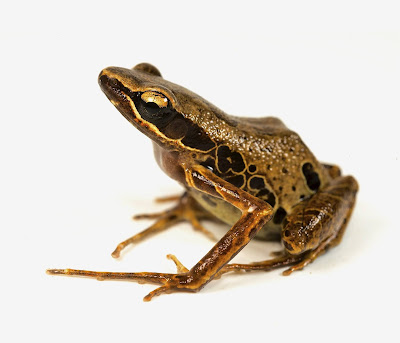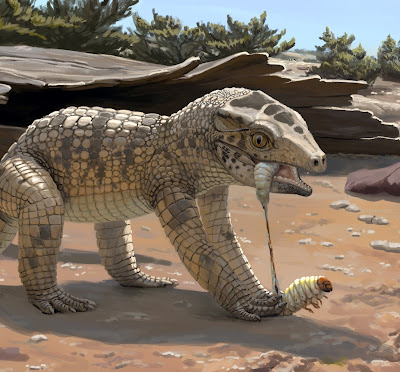[Most Recent Entries] [Calendar View]
Friday, September 10th, 2021
| Time | Event | ||
| 9:30a | [Herpetology • 2021] Phylogeny of African Long-Fingered Frogs (Arthroleptidae: Cardioglossa) reveals Recent Allopatric Divergences in Coloration
Abstract The African anuran genus Cardioglossa contains 19 described species, most of which are distinguished from one another by striking patterns and colors. We present a well-resolved phylogeny based on analyses of mitochondrial and nuclear loci for 18 species of Cardioglossa. This provides the basis for species-delimitation analyses and interpreting historical biogeography in the genus. Whereas much of the diversification within the genus occurred among Central African lineages during the Miocene following the origin of Cardioglossa in the latest Oligocene or earliest Miocene, most species-pairs in the genus diverged more recently during the Plio-Pleistocene. The two most geographically peripheral species—C. cyaneospila in the Albertine Rift Mountains and C. occidentalis in the Upper Guinean Forests of West Africa—both diverged from other lineages during the mid-late Miocene. Because our analyses do not support C. manengouba and C. oreas as distinct species, we recognize these geographically separate and phenotypically distinct populations as subspecies of C. oreas that diverged subsequent to the origin of Mount Manengouba during the past 1.5 million years. In contrast, we find that C. leucomystax likely represents two species found in the Lower Guinean and Congolian forests, respectively. We find recent divergences between several allopatric lineages (either species or populations) that differ in coloration and pattern, including in C. nigromaculata which varies in color across its range in Central Africa and Bioko Island. These recent divergences among allopatric lineages with distinctive coloration and pattern raise new questions about the significance of these traits in this genus for which little is known of its natural history and biology. David C. Blackburn, Stuart V. Nielsen, Sonia L. Ghose, Marius Burger, LeGrand Nono Gonwouo, Eli Greenbaum, Václav Gvoždík, Mareike Hirschfeld, Marcel T. Kouete, Chifundera Kusamba, Dwight Lawson, Patrick J. McLaughlin, Ange-Ghislain Zassi-Boulou and Mark-Oliver Rödel. 2021. Phylogeny of African Long-Fingered Frogs (Arthroleptidae: Cardioglossa) Reveals Recent Allopatric Divergences in Coloration. Ichthyology & Herpetology. 109(3); 728-742. DOI: 10.1643/h2020165 | ||
| 9:34a | [Paleontology • 2021] Eptalofosuchus viridi • First Upper Cretaceous notosuchians (Crocodyliformes) from the Uberaba Formation (Bauru Group), southeastern Brazil: Enhancing Crocodyliform Diversity
Highlights: • Here we describe the first crocodyliforms fossils from the Uberaba Formation. • The material comprises of isolated teeth and a fragmentary mandible of notosuchians. • The isolated teeth represent Bauruchidae and a probable longisrotrine Peirosauridae. • The fragmentary mandible was identified as a new taxon, Eptalofosuchus viridi gen et sp. nov.. Abstract Notosuchians are the most diverse group and are frequently found in rocks of the Upper Cretaceous Bauru Group of southeastern Brazil. These crocodyliforms occupied several different terrestrial ecological niches, ranging from small to large bodied forms, including hypercarnivore to strictly herbivore animals. Most of this diversity comes from the Adamantina and Serra da Galga formations, where baurusuchids, peirosaurids and the so called “advanced notosuchians” are common occurrences. In this context, the Serra da GalgaFormation (formerly Serra da Galga Member of the Marília Formation), that crops out at the Uberaba region, stands out as one of the most prolific Upper Cretaceous units in Brazil. The Uberaba Formation is another unit present in this area, underlying the Serra da Galga Formation, but to date, its crocodyliform diversity is virtually unknown. Here we describe the first notosuchians remains from the Uberaba Formation, and the first new taxon from this unit, Eptalofosuchus viridi gen. et sp. nov., based on a partial dentary with some teeth of an “advanced notosuchian”. The other remains include isolated teeth of a large baurusuchid and a possible longirostrine peirosaurid, suggesting that the Uberaba Formation shared a similar notosuchian fauna with that present in the Adamantina and São José do Rio Preto formations. Keywords: Notosuchia, Baurusuchidae, Peirosauridae, Bauru Basin, Minas Gerais State Thiago S. Marinho, Agustín G. Martinelli, Giorgio Basilici, Marcus Vinícius T. Soares, André Marconato, Luiz C.B. Ribeiro and Fabiano V. Iori. 2021. First Upper Cretaceous notosuchians (Crocodyliformes) from the Uberaba Formation (Bauru Group), southeastern Brazil: Enhancing Crocodyliform Diversity. Cretaceous Research. In Press, 105000. DOI: 10.1016/j.cretres.2021.105000 |
| << Previous Day |
2021/09/10 [Calendar] |
Next Day >> |




